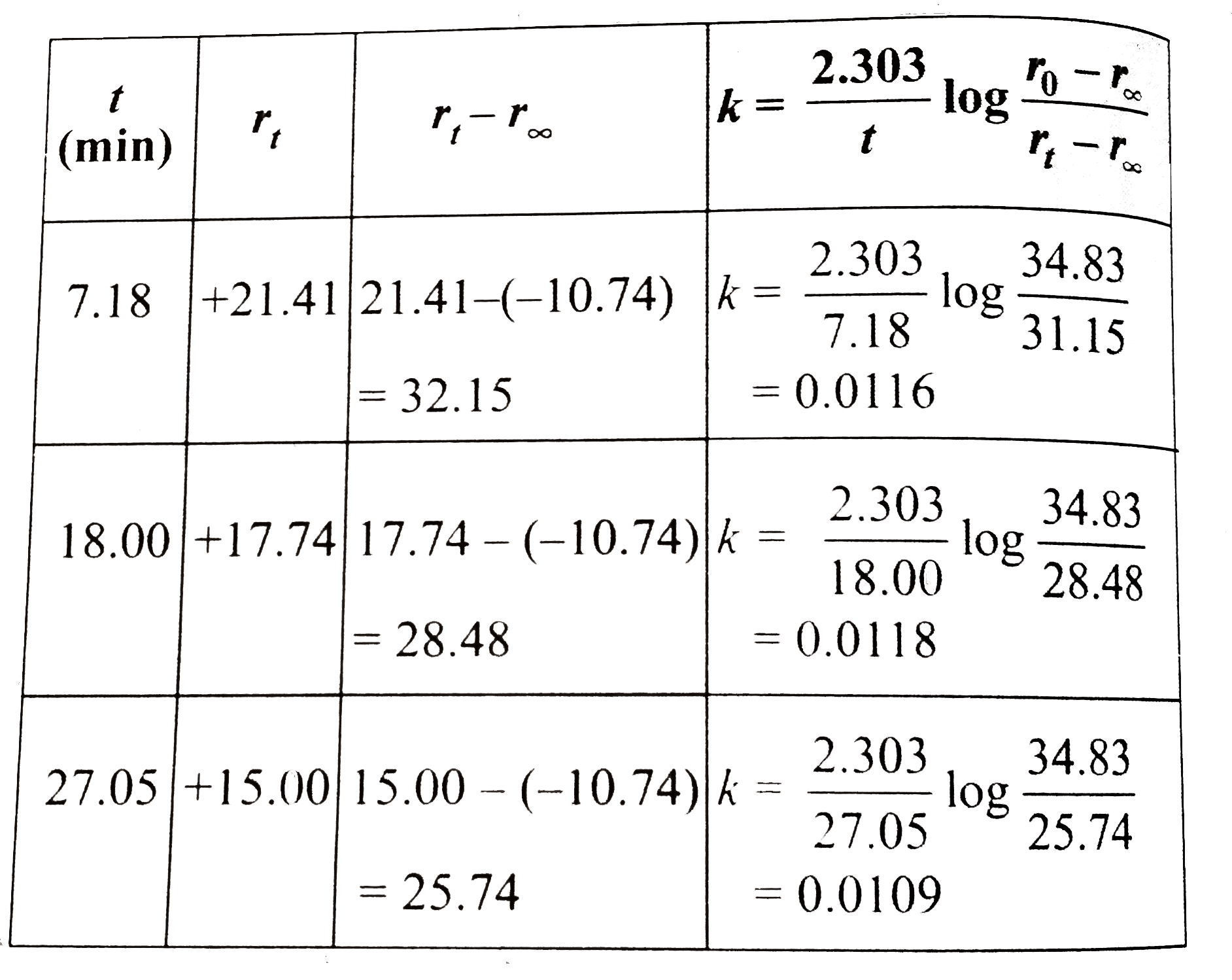The inverison of cane sugar was studied is HCl at 298K. The following polarimetric readings were obtained at different intervals of time:

Show that the inverison of cane sugar is a unimolecular reaction.
In the present case, r0=+24.09,r∞=−10.74
∴r0−r∞=+24.09−(−10.74)=34.83
The value of k at different instants may be calculated as under:

The constancy in the value of k proves that the reaction is of the first order.
Temperature Dependence of a Reaction, Energy of Activation, and Arrhenius Equation
Topper's Solved these Questions
- CHEMICAL KINETICSBook:CENGAGE CHEMISTRY ENGLISHChapter:CHEMICAL KINETICSExercise:Ex 4.1 (Objective)
Explore 9 Videos
- CHEMICAL KINETICSBook:CENGAGE CHEMISTRY ENGLISHChapter:CHEMICAL KINETICSExercise:Ex 4.2 (Objective)
Explore 10 Videos
- CHEMICAL KINETICSBook:CENGAGE CHEMISTRY ENGLISHChapter:CHEMICAL KINETICSExercise:Archives Subjective
Explore 23 Videos
- CARBOXYLIC ACIDS AND THEIR DERIVATIVESBook:CENGAGE CHEMISTRY ENGLISHChapter:CARBOXYLIC ACIDS AND THEIR DERIVATIVESExercise:Exercises Archives (Analytical And Descriptive)
Explore 34 Videos
- COORDINATION COMPOUNDSBook:CENGAGE CHEMISTRY ENGLISHChapter:COORDINATION COMPOUNDSExercise:Archives Subjective
Explore 18 Videos
Similar Questions
The inverison of cane sugar is a……………reaction though its molecularity is………………. .
View SolutionA 20% solution of cane sugar having dextrorotation of 34.50 inverted by 0.5N lactic acid to at 298K. The rotations determined are as follows:
∣∣∣Time (min)014.55111.36∞Rotation34.5031.1013.98−10.77∣∣∣
Show that the inverison of sugar is a unimolecular reaction.
View SolutionThe following results were obtained during kinetic studies of the reaction, 2A+B→ Products

The time (in minutes) required to consume half of A is:
View SolutionThe inverison of cane sugar proceeds with half life of 500min at pH5 for any concentration of sugar. However, if pH=6, if the half life changes to 50min. The rate law expresison for the sugar inverison can be written as
View SolutionIn a pseudo first order hydrolysis of ester in water, the following results were obtained:

Calculate the average rate of reaction between the time interval 30 to 60 seconds.
View SolutionIn a pseudo first order hydrolysis of ester in water, the following results were obtained:

Calculate the average rate of reaction between the time interval 30 to 60 seconds.
View SolutionIn a pseudo first order hydrolysis of ester in water, the following results were obtained:

Calculate the average rate of reaction between the time interval 30 to 60 seconds.
View SolutionHydrolysis of methyl acetate in aqueous solution has been studied by titrating the liberated acetic acid against sodium hydroxide. The concentration of the ester at different times is given below:

Show that it follows a pseudo first order reaction, as the concentration of water remains nearly constant (55 mol L−1) during the course of the reaction. What is the value of k'in this equation? Rate =k'[CH3COOCH3][H2O]
View SolutionHydrolysis of methyl acetate in aqueous solution has been studied by titrating the liberated acetic acid against sodium hydroxide. The concentration of the ester at different times is given below:

Show that it follows a pseudo first order reaction, as the concentration of water remains nearly constant (55 mol L−1) during the course of the reaction. What is the value of k'in this equation? Rate =k'[CH3COOCH3][H2O]
View SolutionHydrolysis of methyl acetate in aqueous solution has been studied by titrating the liberated acetic acid against sodium hydroxide. The concentration of the ester at different times is given below:

Show that it follows a pseudo first order reaction, as the concentration of water remains nearly constant (55 mol L−1) during the course of the reaction. What is the value of k'in this equation? Rate =k'[CH3COOCH3][H2O]
View Solution